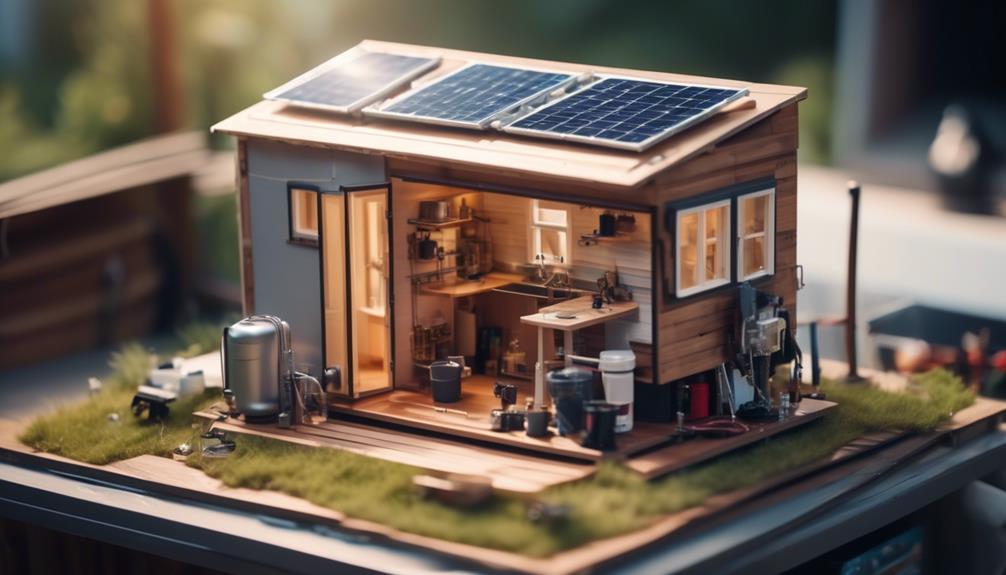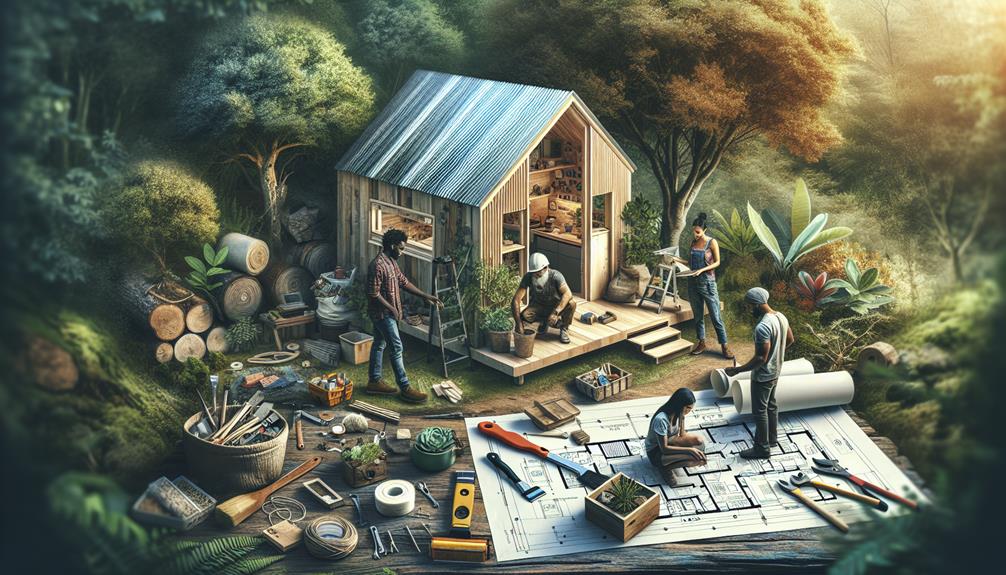Tight budgets need not tether your dreams of tiny home ownership. You've likely seen the surge of interest in tiny homes and the freedom they can offer, both financially and in lifestyle. As a professional with an eye for cost-effective solutions, let's explore the practicalities of piecing together your pint-sized palace without puncturing your wallet.
From selecting salvaged materials to learning the legalities of tiny home living, you'll find that a little knowledge goes a long way. But how can you ensure that your cozy abode is both up to code and uniquely yours?
Stay with me as we unpack the essentials of laying a solid and affordable foundation for your future tiny home.
Key Takeaways
- Carefully plan your budget and consider cost-saving measures like using recycled materials and volunteer labor.
- Prioritize safety and convenience when selecting salvaged materials and seek professional advice for safety-related aspects.
- Evaluate the pros and cons of different foundation options and ensure the structural soundness of a used trailer if chosen.
- Maximize small spaces by using multi-functional furniture, sustainable materials, and smart storage solutions.
Budget Planning Essentials
To stay within your financial means while building a tiny home, it's crucial to meticulously plan your budget, considering both the cost-saving measures and necessary investments to ensure safety and durability.
Start by identifying cost-saving examples from other tiny house builds, like using recycled materials and volunteer labor. Balance frugality with practicality when choosing materials; it's wise to invest in a new trailer for safety. Salvaged materials can save money, but prioritize your well-being by selecting items that won't compromise safety or convenience.
Incorporate the benefits of a low-cost tiny home into your planning to build, aligning your budget with the goal of affordability and minimal environmental impact. Factor in lifestyle changes and ongoing costs, seeking experienced advice, and hiring professionals when safety is at stake.
Choosing Your Foundation
When selecting your tiny home's foundation, you'll need to weigh the pros and cons of various types such as trailers, concrete slabs, or pier blocks.
Prepare your site carefully, ensuring it's level and stable to avoid costly adjustments later on.
Keep a close eye on your budget, accounting for all materials and labor to prevent unexpected expenses in this foundational phase of construction.
Foundation Types Compared
Selecting the right foundation for your tiny home hinges on balancing cost, durability, and the specific needs of your location. When you're ready to build a tiny home, an important step is comparing foundation types.
A concrete slab is cost-effective and offers a sturdy base, while pier and beam adapt to varied terrain and ease utility access. Opting for a trailer foundation provides the ultimate mobility, enabling you to relocate with ease—an innovative twist to building a tiny house.
Skids represent a frugal choice, granting portability and straightforward installation. Lastly, integrating a crawl space is your next step toward added storage and securing your home from moisture.
Each type brings unique benefits, so weigh these options carefully to match your pioneering tiny home vision.
Site Preparation Essentials
Having compared foundation types, you'll next need to meticulously prepare your site to ensure the chosen base can support your tiny home effectively. As you embark on building a tiny home, site preparation essentials become the critical place to start. Here's a step-by-step guide:
- Evaluate the ground stability
- Check for levelness
- Assess drainage conditions
- Remove debris and vegetation
- Clear the area of rocks, roots, and organic matter
- Ensure a clean, stable surface
- Mark the foundation perimeter
- Use stakes and string for precise boundaries
- Account for all dimensions of your tiny build
Budgeting Foundation Costs
To effectively manage your expenses, consider a used trailer as a foundation for your tiny home, a choice that has helped many, including Macy Miller and others, significantly cut down on costs.
While you build your tiny house, it's crucial to weigh the pros and cons of various foundation options. A used trailer can offer a substantial savings, but ensure it's structurally sound to avoid compromising safety.
For the DIY Tiny House enthusiast, salvaging materials is a smart move, but be methodical in your selection, prioritizing stability and durability. When constructing your tiny house, the foundation isn't where you want to skimp—balance the savings with the necessity of a secure base.
This approach will guide you in building a tiny home that's both affordable and safe.
Designing Your Tiny Home
When designing your tiny home, you'll need to maximize every square inch, so consider multi-functional furniture and built-in storage to use space efficiently.
Opt for sustainable materials that are both durable and eco-friendly, like bamboo flooring or recycled metal siding.
Plan a functional layout that separates living areas from private spaces smartly, ensuring a comfortable flow throughout your tiny home.
Maximizing Small Spaces
Maximize every inch of your tiny home by selecting multi-functional furniture and clever storage solutions that serve dual purposes without compromising on style or comfort.
Your tiny house floor plan should include:
- Convertible Furniture:
- Sofa beds that transform into sleep spaces
- Drop-leaf tables that expand for dining or contract for additional floor space
- Smart Storage:
- Built-in drawers under staircases
- Wall-mounted shelves reaching up high
When you're designing, think vertical. Lofted beds aren't just for sleeping; see how much extra room you gain beneath. Choose sliding walls to turn one room into two when needed.
Choosing Sustainable Materials
While considering the layout and multifunctionality of your tiny home's interior, it's equally important to focus on the materials you choose, ensuring they're as sustainable as they're stylish.
Dive into the world of recycled and salvaged materials to minimize your environmental impact while cutting costs. Opt for reclaimed wood, bamboo, or recycled metal to champion eco-friendly construction.
Don't overlook energy-efficient insulation, windows, and roofing; these elements are vital for sustainability and energy savings. Source these sustainable materials from local suppliers to slash transportation emissions and bolster community businesses.
Emphasize durability and longevity to maximize long-term environmental benefits. Integrate solar panels for renewable energy, install a house wrap for added insulation, and ensure proper ventilation to prevent carbon monoxide buildup.
Your tiny house can be a beacon of innovation and sustainability.
Functional Layout Considerations
To make every inch count in your tiny home, strategically design your space to include multifunctional furniture and vertical storage solutions. Your functional layout considerations should focus on maximizing the living space while maintaining comfort and style. Here's how to refine your design:
Maximize vertical space:
- Install shelving units above doorways
- Use wall-mounted fold-down desks or tables
Multipurpose furniture:
- Choose sofas with storage or that convert into beds
- Opt for ottomans that double as seating and storage
Ensure your tiny home feels open by strategically placing windows and doors to invite natural light. Incorporate energy-efficient systems for insulation. Fit a large shed's functionality into your compact layout by planning the placement of the kitchen, bathroom, and sleeping areas with precision.
Lastly, add those finishing touches that turn a house into your home.
Essential Construction Steps
Begin planning your tiny home by meticulously designing its layout, ensuring that you optimize the small living space to suit your needs. Once you've imagined living small, it's time to build your tiny house on a suitable location, whether it's a stationary plot or on wheels for mobility.
Make sure to construct the floor with standard lumber, reinforcing any weak points, and sheathing with plywood or OSB for stability. Follow the essential construction steps carefully, moving on to frame the walls. Use metal bracing and sheath them with plywood or OSB, creating a robust structure.
For the roof, opt for a simple design for easier construction. Frame it, sheath with plywood or OSB, and finish with standing seam metal to ensure your walls and roof withstand the test of time.
Installing Utilities

Once your tiny home's structure stands firm, it's time to tackle the crucial task of installing utilities, starting with identifying your water and power sources. Here's a methodical approach:
- Determine Sources:
- Water: Could be a hookup, well, or rainwater collection.
- Power: Grid connection, solar panels, or generator.
- Plan Layout:
- Plumbing: Prioritize compact designs, but don't compromise on accessibility for maintenance.
- Electrical: Map out where you'll need outlets and lighting fixtures; consider energy-efficient options.
Interior and Exterior Finishing
After ensuring your tiny home is equipped with essential utilities, focus shifts to the interior and exterior finishing, where your choices in materials and design will establish both the appearance and the resilience of your living space. Start with proper insulation and weatherproofing to protect your house from the elements, ensuring comfort year-round. Opt for cost-effective yet durable materials that offer longevity without breaking your budget.
When customizing, consider the tiny life philosophy of simplicity with style. Use trim work, paint, and flooring to add personal touches that make the space feel like a home, not just a house. If you're planning a guest suite, aim for a welcoming vibe with innovative storage solutions to maximize the area. The right finishing touches will turn your tiny house into a cozy, appealing home.
Frequently Asked Questions
What Is the Cheapest You Can Build a Tiny House?
You can build a tiny house cheaply by sourcing secondhand fixtures, creating DIY furniture, choosing affordable insulation, and attending community workshops. Be smart with materials to cut costs without compromising safety or quality.
How to Build a Tiny House on a Budget?
To build your tiny house frugally, focus on material sourcing from salvage, create DIY designs, attend community workshops, incorporate upcycled furnishings, and adhere to meticulous budget planning for cost-effective solutions.
Is It Hard to Build Your Own Tiny House?
Navigating the tiny house construction maze isn't a walk in the park. You'll face design challenges, zoning regulations, and material sourcing, requiring solid DIY skills and custom solutions to craft your innovative abode.
Why Did Tiny House Nation Get Cancelled?
Tiny House Nation got cancelled due to a legal squabble over unpaid wages and contract violations. Despite this, tiny house trends endure, with viewer engagement shifting to show alternatives amidst the market's evolution.
Conclusion
So, you've scrimped, saved, and scrounged every nail and nook. You've traded the grand for the grounded, crafting a home no larger than a parking spot.
Yet, in this tiny abode, you've built something immense: independence. Isn't it ironic? By thinking small, you've achieved something quite big.
Now, as you stand in your pint-sized palace, remember, it's not just a house—it's a testament to meticulous planning and the might of minimalism.
Welcome home.

